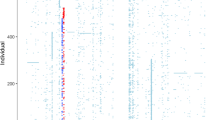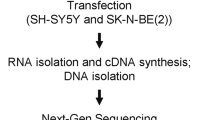Abstract
Because tolerance is an important aspect of alcohol dependence (AD) in humans, recent evidence showing that the Drosophila gene hang is critically involved in the development of alcohol tolerance in the fly suggests that variation in related human loci might be important in the etiology of alcohol-related disorders. The orthology of hang in mammals is complex, but a number of human gene products (including ZNF699) with similar levels of amino-acid identity (18–26%) and similarity (30–41%), are consistently identified as the best matches with the translated hang sequence. We tested for association between the dichotomous clinical phenotype of alcohol dependence and seven single nucleotide polymorphisms (SNPs) in ZNF699 in our sample of 565 genetically independent cases and 496 siblings diagnosed with AD, and 609 controls. In analyses of genetically independent cases and controls, four of the seven single markers show strong evidence for association with AD (0.00003<Fisher's exact P<0.001), and the most significant single marker, rs7254880, tags an associated haplotype with frequency 0.071 in cases compared to 0.034 in controls (χ2 15.563, P<0.00008, 5000 permutation P<0.001, OR 2.17); inclusion of affected siblings gives similar results. Expression analyses conducted in independent postmortem brain samples show that expression of ZNF699 mRNA is significantly reduced in the dorsolateral prefrontal cortex of individuals carrying this haplotype compared with other observed haplotype combinations.
This is a preview of subscription content, access via your institution
Access options
Subscribe to this journal
Receive 12 print issues and online access
$259.00 per year
only $21.58 per issue
Buy this article
- Purchase on Springer Link
- Instant access to full article PDF
Prices may be subject to local taxes which are calculated during checkout


Similar content being viewed by others
References
Kessler RC, McGonagle KA, Zhao S, Nelson CB, Hughes M, Eshleman S et al. Lifetime and 12-month prevalence of DSM-III-R psychiatric disorders in the United States. Results from the National Comorbidity Survey. Arch Gen Psychiatry 1994; 51: 8–19.
Grant BF . Prevalence and correlates of alcohol use and DSM-IV alcohol dependence in the United States: results of the National Longitudinal Alcohol Epidemiologic Survey. J Stud Alcohol 1997; 58: 464–473.
Prescott CA . The genetic epidemiology of alcoholism: sex differences and future directions. In: Agarwal DP, Seitz HK (eds). Alcohol in Health and Disease. Marcel Dekker: New York, 2001, pp 125–149.
Zucker RA, Gomberg ES . Etiology of alcoholism reconsidered. The case for a biopsychosocial process. Am Psychol 1986; 41: 783–793.
Prescott CA, Sullivan PF, Kuo PH, Webb BT, Vittum J, Patterson DG et al. Genomewide linkage study in the Irish affected sib pair study of alcohol dependence: evidence for a susceptibility region for symptoms of alcohol dependence on chromosome 4. Mol Psychiatry 2006; 11: 603–611.
American Psychiatric Association. Diagnostic and Statistical Manual of Mental Disorders – Fourth Edition. American Psychiatric Association: Washington, DC, 1994.
Tabakoff B, Cornell N, Hoffman PL . Alcohol tolerance. Ann Emerg Med 1986; 15: 1005–1012.
Le AD, Mayer JM . Acute tolerance. In: Dietrich RA, Erwin VG (eds). Pharmacological Effects of Ethanol on the Nervous System. CRC Press: Boca Raton, 1996, pp 251–268.
Fadda F, Rossetti ZL . Chronic ethanol consumption: from neuroadaptation to neurodegeneration. Prog Neurobiol 1998; 56: 385–431.
Scholz H, Ramond J, Singh CM, Heberlein U . Functional ethanol tolerance in Drosophila. Neuron 2000; 28: 261–271.
Scholz H, Franz M, Heberlein U . The hangover gene defines a stress pathway required for ethanol tolerance development. Nature 2005; 436: 845–847.
Weber KE, Diggins LT . Increased selection response in larger populations. II. Selection for ethanol vapor resistance in Drosophila melanogaster at two population sizes. Genetics 1990; 125: 585–597.
Moore MS, DeZazzo J, Luk AY, Tully T, Singh CM, Heberlein U . Ethanol intoxication in Drosophila: genetic and pharmacological evidence for regulation by the cAMP signaling pathway. Cell 1998; 93: 997–1007.
Singh CM, Heberlein U . Genetic control of acute ethanol-induced behaviors in Drosophila. Alcohol Clin Exp Res 2000; 24: 1127–1136.
Prescott CA, Sullivan PF, Myers JM, Patterson DG, Devitt M, Halberstadt LJ et al. The Irish affected sib pair study of alcohol dependence: study methodology and validation of diagnosis by interview and family history. Alcohol Clin Exp Res 2005; 29: 417–429.
Bucholz KK, Cadoret R, Cloninger CR, Dinwiddie SH, Hesselbrock VM, Nurnberger Jr JI et al. A new, semi-structured psychiatric interview for use in genetic linkage studies: a report on the reliability of the SSAGA. J Stud Alcohol 1994; 55: 149–158.
Torrey EF, Webster M, Knable M, Johnston N, Yolken RH . The Stanley Foundation Brain Collection and Neuropathology Consortium. Schizophr Res 2000; 44: 151–155.
Chen X, Levine L, Kwok PY . Fluorescence polarization in homogeneous nucleic acid analysis. Genome Res 1999; 9: 492–498.
Van den Oord EJCG, Jiang Y, Riley BP, Kendler KS, Chen X . FP-TDI SNP genotype scoring by manual and statistical procedures: a study of error rates and types. Biotechniques 2003; 34: 610–624.
Vandesompele J, De Preter K, Pattyn F, Poppe B, Van Roy N, De Paepe A et al. Accurate normalization of real-time quantitative RT-PCR data by geometric averaging of multiple internal control genes. Genome Biol 2002; 3: research0034.1–research0034.11.
Livak KJ, Schmittgen TD . Analysis of relative gene expression data using real-time quantitative PCR and the 2(-Delta Delta C(T)) method. Methods 2001; 25: 402–408.
Stephens M, Smith NJ, Donnelly P . A new statistical method for haplotype reconstruction from population data. Am J Hum Genet 2001; 68: 978–989.
Stephens M, Donnelly P . A comparison of bayesian methods for haplotype reconstruction from population genotype data. Am J Hum Genet 2003; 73: 1162–1169.
Barrett JC, Fry B, Maller J, Daly MJ . Haploview: analysis and visualization of LD and haplotype maps. Bioinformatics 2005; 21: 263–265.
SAS Institute. SAS v9, Cary, NC, 2002.
Adams MD, Celniker SE, Holt RA, Evans CA, Gocayne JD, Amanatides PG et al. The genome sequence of Drosophila melanogaster. Science 2000; 287: 2185–2195.
Urrutia R . KRAB-containing zinc-finger repressor proteins. Genome Biol 2003; 4: 231.
Altschul SF, Madden TL, Schaffer AA, Zhang J, Zhang Z, Miller W et al. Gapped BLAST and PSI-BLAST: a new generation of protein database search programs. Nucleic Acids Res 1997; 25: 3389–3402.
Gabriel SB, Schaffner SF, Nguyen H, Moore JM, Roy J, Blumenstiel B et al. The structure of haplotype blocks in the human genome. Science 2002; 296: 2225–2229.
Berger KH, Heberlein U, Moore MS . Rapid and chronic: two distinct forms of ethanol tolerance in Drosophila. Alcohol Clin Exp Res 2004; 28: 1469–1480.
Markel PD, Bennett B, Beeson M, Gordon L, Johnson TE . Confirmation of quantitative trait loci for ethanol sensitivity in long-sleep and short-sleep mice. Genome Res 1997; 7: 92–99.
Bennett B, Johnson TE . Development of congenics for hypnotic sensitivity to ethanol by QTL-marker-assisted counter selection. Mamm Genome 1998; 9: 969–974.
Bennett B, Beeson M, Gordon L, Carosone-Link P, Johnson TE . Genetic dissection of quantitative trait loci specifying sedative/hypnotic sensitivity to ethanol: mapping with interval-specific congenic recombinant lines. Alcohol Clin Exp Res 2002; 26: 1615–1624.
Ehringer MA, Thompson J, Conroy O, Yang F, Hink R, Bennett B et al. Fine mapping of polymorphic alcohol-related quantitative trait loci candidate genes using interval-specific congenic recombinant mice. Alcohol Clin Exp Res 2002; 26: 1603–1608.
Kubota H, Yokota S, Yanagi H, Yura T . Transcriptional regulation of the mouse cytosolic chaperonin subunit gene Ccta/t-complex polypeptide 1 by selenocysteine tRNA gene transcription activating factor family zinc finger proteins. J Biol Chem 2000; 275: 28641–28648.
Mulligan MK, Ponomarev I, Hitzemann RJ, Belknap JK, Tabakoff B, Harris RA et al. Toward understanding the genetics of alcohol drinking through transcriptome meta-analysis. Proc Natl Acad Sci USA 2006; 103: 6368–6373.
Legrain P, Choulika A . The molecular characterization of PRP6 and PRP9 yeast genes reveals a new cysteine/histidine motif common to several splicing factors. EMBO J 1990; 9: 2775–2781.
Schuckit MA, Smith TL, Tipp JE . The self-rating of the effects of alcohol (SRE) form as a retrospective measure of the risk for alcoholism. Addiction 1997; 92: 979–988.
Acknowledgements
We thank Andrew Davies, Jill Bettinger and Michael Miles for helpful discussions of this work, and Andrew Davies for a critical reading of the manuscript and helpful comments on it. This work was supported by NIH Grant AA110408.
Author information
Authors and Affiliations
Corresponding author
Supplementary information
Rights and permissions
About this article
Cite this article
Riley, B., Kalsi, G., Kuo, PH. et al. Alcohol dependence is associated with the ZNF699 gene, a human locus related to Drosophila hangover, in the Irish affected sib pair study of alcohol dependence (IASPSAD) sample. Mol Psychiatry 11, 1025–1031 (2006). https://doi.org/10.1038/sj.mp.4001891
Received:
Accepted:
Published:
Issue Date:
DOI: https://doi.org/10.1038/sj.mp.4001891
Keywords
This article is cited by
-
Studying alcohol use disorder using Drosophila melanogaster in the era of ‘Big Data’
Behavioral and Brain Functions (2019)
-
Drosophila melanogaster as a model to study drug addiction
Human Genetics (2012)



